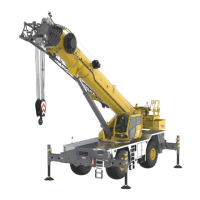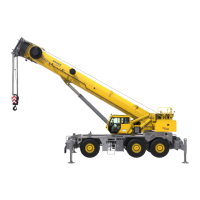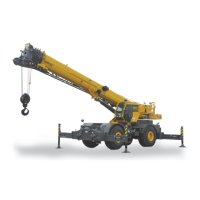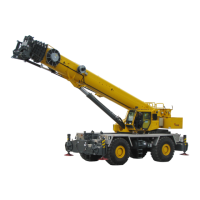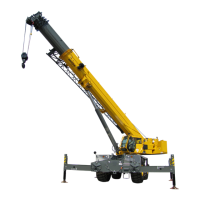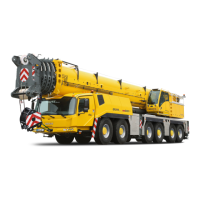HYDRAULIC SYSTEM GRT8100 SERVICE MANUAL
2-52
Published 3/26/2018, Control # 596-05
ACCESSORY MANIFOLD VALVE
Description
The accessory manifold valve (Figure 2-26 through
Figure 2-28) is located on the superstructure side plate
(Figure 2-18) and includes valves for controlling the front
steer, swing brake, pilot supply, and telescope fill tube.
Front Steer
Supply oil for this valve comes from pump No. 2.
When the steer function is not activated, pressure held in the
steer circuit shifts the priority flow valve to allow all the flow to
pass through and onto the main directional control valve
were it adds to the flow from pump No. 1. Upon actuating the
steer function, the pressure through the load sense circuit
shifts the priority flow valve to allow the proper amount of
flow to the steering unit while the load sense relief keeps the
steering pressure limited to 2800 psi.
A pressure reducing valve reduces pump pressure to
3250 psi for all other functions receiving supply oil from this
valve assembly.
Swing Brake
The (static) swing brake is spring-applied, hydraulic released
while the service (dynamic) brake is pressure applied. A two
position solenoid valve controls the pressure to release the
swing brake. A pressure reducing valve maintains a pressure
of 260 to 300 psi to the inlet of both the brake release and
brake apply valves. The circuit is designed such that when
the engine is running and the swing enable switch is
activated pressure is supplied to the swing brake release to
release the brake while at the same time pressure is ramped
up on the swing service brake proportionally to the max
pressure. When the swing control joystick is actuated to
swing left or right, the proportional valve is de-energized
there by releasing the pressure from the swing service brake
and allowing motion. When the swing joystick is returned to
the center (neutral) position, the control system gradually re-
energizes the proportional valve (apply valve), thereby
slowly increasing oil pressure to apply the brake. Actuating
the swing brake foot pedal results in the same action.
Pilot Supply
A pressure reducing valve set to 600 psi and a control valve
supply the pilot supply oil to control the following valves and
functions:
• Main directional control valve on the superstructure,
which includes valves for controlling the auxiliary hoist,
main hoist, boom telescope, and boom lift functions.
• Main and auxiliary hoist brakes (for brake release in the
raise direction).
• Telescope stage selector circuit.
Fill Tube
The fill tube pressure regulating valve is a two-position,
solenoid controlled, proportional valve that works with the
telescope and tele stage select valve manifold to prevent the
movement of the first stage (boom tele sections 2, 3, and 4)
when the second stage (tele section 1) extends or retracts by
maintaining oil pressure in the fill tube of the first stage and,
conversely, the valve prevents the second stage from
moving as the first stage extends or retracts by maintaining
oil pressure in the fill tube of the second stage.
Maintenance
Removal
1. Tag and disconnect the electrical connectors to all
valves.
2. Tag and disconnect the hydraulic lines from the
manifold. Cap or plug the lines and ports.
3. Remove the capscrews, lockwashers and flatwashers
securing the manifold. Remove the manifold and two
spacer bushings.
Installation
1. Position the manifold and spacer bushings on turntable
and secure with the capscrews, flatwashers and
lockwashers. Torque capscrews - refer to Fasteners and
Torque Values, page 1-15 for proper torque value.
2. Connect the hydraulic lines to the manifold as tagged
during removal.
3. Connect the electrical connectors to the manifold as
tagged during removal.
Function Check - Front Steer
1. Start the engine.
2. Drive the crane at a slow speed and verify the front
steering function works properly.
Function Check - Swing Brake Release Valve
1. Start the engine.
2. Enable all crane functions using the crane function
switch to on.
3. Swing the turntable to verify the swing brake releases.
Depress the swing brake pedal to stop the turntable.
4. Position the swing enable switch to off and verify the
swing brake applied icon appears on the CCS display.
5. Activate the swing function and ensure the turntable
does not rotate.
6. Check for leaks. Make repairs as needed.
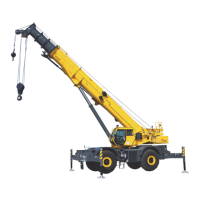
